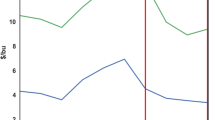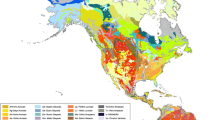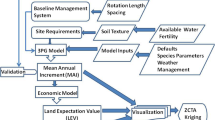Abstract
The increasing interest in energy production from biomass requires a better understanding of potential local production and environmental impacts. This information is needed by local producers, biomass industry, and other stakeholders, and for larger scale analyses. This study models biomass production decisions at the field level using a case example of a biomass gasification facility constructed at the University of Minnesota—Morris (UMM). This institutional-scale application has an anticipated feedstock demand of about 8,000 Mg year−1. The model includes spatial impacts due to sub-field variation in soil characteristics and transportation costs. Results show that the amount of biomass producers could profitably supply within a 32.2-km radius of UMM increases as plant-gate biomass price increases from $59 to $84 Mg−1, with 588,000 Mg annual biomass supply at $84 Mg−1. Results also show that the most profitable tillage and crop rotation practices shift in response to increasing biomass price with producers shifting from a corn-soybean rotation toward continuous corn. While biomass harvest is conducive to increased soil erosion rates and reduced soil organic carbon levels, changes in crop production practices are shown to at least partially offset these impacts. Transportation costs tend to concentrate and intensify biomass production near the biomass facility, which also tends to concentrate environmental impacts near the facility.









Similar content being viewed by others
Abbreviations
- CP:
-
Chisel plow
- ST:
-
Strip-tillage
- C:
-
Corn
- SB:
-
Soybean
- SW:
-
Spring wheat
- CC:
-
Continuous corn
- UMM:
-
University of Minnesota—Morris
- SOC:
-
Soil organic carbon
- CDL:
-
Cropland data layer
- EPIC:
-
Environmental Policy Integrated Climate
- SSURGO:
-
Soil Survey Geographic
References
USGPO (2007) Energy Independence and Security Act of 2007: Public Law 110-140. US Government Printing Office, Washington
Landis DA, Gardiner MM, van der Werf W, Swinton SM (2008) Increasing corn for biofuel production reduces biocontrol services in agricultural landscapes. Proc Natl Acad Sci USA 105:20552–20557
McCarl BA, Maung T, Szulczyk KR (2009) Could bioenergy be used to harvest the greenhouse: an economic investigation of bioenergy and climate change? In: Khanna M, Scheffran J, Zilberman D (eds) Handbook of bioenergy economics and policy. Springer, New York, pp 195–218
Gottfried R, Wear D, Lee R (1996) Institutional solutions to market failure on the landscape scale. Ecol Econ 18:133–140
Lant CL, Kraft SE, Beaulieu J, Bennett D, Loftus T, Nicklow J (2005) Using GIS-based ecological–economic modeling to evaluate policies affecting agricultural watersheds. Ecol Econ 55:467–484
English BC, De La Torre Ugarte DG, Walsh ME, Hellwinkel C, Menard J (2006) Economic competitiveness of bioenergy production and effects on agriculture of the Southern region. J Agr Appl Econ 38:389–402
Schneider UA, McCarl BA (2003) Economic potential of biomass based fuels for greenhouse gas emission mitigation. Environ Resour Econ 24:291–312
Malcolm S, Aillery M, Weinberg M (2009) Ethanol and a changing agricultural landscape. USDA Economic Research Service, Washington
Sheehan J, Aden A, Paustian K, Killian K, Brenner J, Walsh M et al (2003) Energy and environmental aspects of using corn stover for fuel ethanol. J Ind Ecol 7:117–146
Petrolia DR (2008) An analysis of the relationship between demand for corn stover as an ethanol feedstock and soil erosion. Rev Agr Econ 30:677–691
Graham RL, English BC, Noon CE (2000) A geographic information system-based modeling system for evaluating the cost of delivered energy crop feedstock. Biomass Bioenerg 18:309–329
Khanna M, Dhungana B, Clifton-Brown J (2008) Costs of producing miscanthus and switchgrass for bioenergy in Illinois. Biomass Bioenerg 32:482–493
Dale VE, Lowrance R, Mulholland P, Robertson GP (2010) Bioenergy sustainability at the regional scale. Ecol Soc 15:23
Lal R (2008) Crop residues as soil amendments and feedstocks for bioethanol production. Waste Manag 28:747–758
Blanco-Canqui H, Lal R (2009) Crop residue removal impacts on soil productivity and environmental quality. Crit Rev Plant Sci 28:129–163
Johnson JMF, Papiernik SK, Mikha MM, Spokas KA, Tomer MD, Weyers SL (2010) Soil processes and residue harvest management. In: Lal R, Stewart BA (eds) Advances in soil science. CRC, Boca Raton, pp 1–44
Kim S, Dale BE (2005) Life cycle assessment of various cropping systems utilized for producing biofuels: bioethanol and biodiesel. Biomass Bioenerg 29:426–439
Janzen HH (2005) Soil carbon: a measure of ecosystem response in a changing world? Can J Soil Sci 85:467–480
Wilhelm WW, Johnson JMF, Hatfield JL, Voorhees WB, Linden DR (2004) Crop and soil productivity response to corn residue removal: a literature review. Agron J 96:1–17
Hooker BA, Morris TF, Peters R, Cardon ZG (2005) Long-term effects of tillage and corn stalk return on soil carbon dynamics. Soil Sci Soc Am J 69:188–196
Gollany HT, Novak JM, Liang Y, Albrecht SL, Rickman RW, Follet RF et al (2010) Simulating soil organic carbon dynamics with residue removal using the CQESTR model. Soil Sci Soc Am J 74:372–383
Kim S, Dale BE, Jenkins R (2009) Life cycle assessment of corn grain and corn stover in the United States. Int J Life Cycle Ass 14:160–174
Adler PR, Del Grosso SJ, Parton WJ (2007) Life-cycle assessment of net greenhouse-gas flux for bioenergy cropping systems. Ecol Appl 17:675–691
Zhang X, Izaurralde RC, Manowitz D, West TO, Post WM, Thomson AM et al (2010) An integrative modeling framework to evaluate the productivity and sustainability of biofuel crop production systems. Global Change Biol Bioenerg 2:258–277
Kim H, Kim S, Dale BE (2009) Biofuels, land use change, and greenhouse gas emissions: some unexplored variables. Environ Sci Tech 43:961–967
Gregg JS, Izaurralde RC (2009) Effect of crop residue harvest on long-term crop yield, soil erosion and nutrient balance: trade-offs for a sustainable bioenergy feedstock. Biofuels 1:69–83
English BC, Menard J, De La Torre Ugarte DG (2001) Using corn stover for ethanol production: a look at the regional economic impacts for selected Midwestern states. University of Tennessee, Knoxville. http://web.utk.edu/∼aimag/pubs/cornstover.pdf. Cited 12 Dec 2011
Gallagher PW, Dikeman M, Fritz J, Wailes E, Gauthier W, Shapouri H (2003) Supply and social cost estimates for biomass from crop residues in the United States. Environ Resour Econ 24:335–358
Graham RL, Nelson R, Sheehan J, Perlack RD, Wright LL (2007) Current and potential U.S. corn stover supplies. Agron J 99:1–11
Wilhelm WW, Johnson JMF, Karlen DL, Lightle DT (2007) Corn stover to sustain soil organic carbon further constrains biomass supply. Agron J 99:1665–1667
Kurkalova LA, Secchi S, Gassman PW (2009) Corn stover harvesting: potential supply and water quality implications. In: Khanna M, Zilberman D, Shaffran J (eds) Handbook of bioenergy economics and policy. Springer, New York, pp 307–323
Secchi S, Kurkalova L, Gassman PW, Hart C (2011) Land use change in a biofuels hotspot: the case of Iowa, USA. Biomass Bioenerg 35:2391–2400
USDA-NASS (2011) Quick Stats 1.0. USDA National Agricultural Statistics Service http://www.nass.usda.gov/Data_and_Statistics/Quick_Stats/index.asp. Cited 12 Dec 2011
Fisher SJ, Moore R (2008) 2007 Tillage transect survey. Water Resources Center, Minnesota State University, Mankato
USDA-NRCS (2011) Soil Survey Geographic Database. USDA Natural Resources Conservation Service http://soils.usda.gov/survey/geography/ssurgo/. Cited 12 Dec 2011
USDA-NRCS (2011) Field Office Technical Guide. US Department of Agriculture, Natural Resources Conservation Service, Washington. http://efotg.sc.egov.usda.gov//efotg_locator.aspx. Cited 12 Dec 2011
NOAA-NCDC (2001) Climatography of the United States no. 81: 21 Minnesota. US Deparment of Commerce National Oceanic and Atmospheric Administration, National Climatic Data Center, Asheville
Williams JR, Jones CA, Dyke PT (1984) A modeling approach to determining the relationship between erosion and soil productivity. Trans ASAE 27:129–144
Gassman PW, Campbell T, Izaurralde RC, Thomson AM, Atwood JD (2003) Regional estimation of soil carbon and other environmental indicators using EPIC and i_EPIC. Center for Agricultural and Rural Development, Iowa State University, Ames
Walsh ME (2000) Method to estimate bioenergy crop feedstock supply curves. Biomass Bioenerg 18:283–289
James LK, Swinton SM, Thelen KD (2010) Profitability analysis of cellulosic energy crops compared with corn. Agron J 102:675–687
Lazarus WF (2009) Machinery cost estimates. University of Minnesota Extension, St. Paul
USDA-NASS (2010) Agricultural Prices. Pr 1 (4-10) U.S. Department of Agriculture, National Agricultural Statistics Service, Washington. http://usda.mannlib.cornell.edu/usda/nass/AgriPric/2010s/2010/AgriPric-04-30-2010.pdf. Cited 12 Dec 2011
Archer DW, Reicosky DC (2009) Economic performance of alternative tillage systems in the northern Corn Belt. Agron J 101:296–304
Kurkalova LA, Kling CL, Zhao J (2006) Green subsidies in agriculture: estimating the adoption cost of conservation tillage from observed behavior. Can J Agr Econ 54:247–267
Shinners KJ, Binversie BN, Muck RE, Weimer PJ (2007) Comparison of wet and dry corn stover harvest and storage. Biomass Bioenerg 31:211–221
Petrolia DR (2008) The economics of harvesting and transporting corn stover for conversion to fuel ethanol: a case study for Minnesota. Biomass Bioenerg 32:603–612
Lafond GP, Stumborg M, Lemke R, May WE, Holzapfel CB, Campbell CA (2009) Quantifying straw removal through baling and measuring the long-term impact on soil quality and wheat production. Agron J 101:529–537
Patterson PE (2003) Availability of straw in eastern Idaho. University of Idaho Extension, Idaho Falls
Johnson J, Wilhelm W, Karlen D, Archer D, Wienhold B, Lightle D et al (2010) Nutrient removal as a function of corn stover cutting height and cob harvest. BioEnergy Res 3:342–352
Hoskinson RL, Karlen DL, Birrell SJ, Radtke CW, Wilhelm WW (2007) Engineering, nutrient removal, and feedstock conversion evaluations of four corn stover harvest scenarios. Biomass Bioenerg 31:126–136
Sawyer JE, Mallarino AP, Killorn R, Barnhart SK (2011) A general guide for crop nutrient and limestone recommendations in Iowa. Iowa State University Extension, Ames. http://www.extension.iastate.edu/Publications/PM1688.pdf. Cited 12 Dec 2011
Jacobsen J, Jackson G, Jones C (2005) Fertilizer guidelines for Montana crops. Montana State University Extension, Bozeman, MT. http://msuextension.org/publications/AgandNaturalResources/EB0161.pdf. Cited 12 Dec 2011
White LM, Hartman GP, Bergman JW (1981) In vitro digestibility, crude protein, and phosphorus content of straw of winter wheat, spring wheat, barley, and oat cultivars in eastern Montana. Agron J 73:117–121
Neitsch SL, Arnold JG, Kiniry JR, Srinivasan R, Williams JR (2004) Soil and water assessment tool input/output file documentation version 2005. Grassland, Soil and Water Research Laboratory and Blackland Research Center, Temple
Morey RV, Kaliyan N, Tiffany DG, Schmidt DR (2010) A corn stover supply logistics system. Appl Eng Agric 26:455–461
Perlack RD, Turhollow AF (2002) Assessment of options for the collection, handling, and transport of corn stover. Oak Ridge National Laboratory, Oak Ridge
Sokhananj S, Turhollow AF (2002) Baseline cost for corn stover collection. Appl Eng Agric 18:525–530
Mn/DOT (2011) GIS Basemap Datafiles. Minnesota Department of Transportation, St. Paul. http://www.dot.state.mn.us/maps/gisbase/html/county_text.html. Cited 12 Dec 2011
USDA-AMS (2010) Grain Transportation Quarterly Updates. 2nd Quarter 2010, 19 Aug 2010. USDA Agricultural Marketing Service, Washington. http://www.ams.usda.gov/AMSv1.0/getfile?dDocName=STELPRDC5086168&acct=graintransrpt. Cited 12 Dec 2011
Archer DW, Jaradat AA, Johnson JMF, Weyers SL, Gesch RW, Forcella F et al (2007) Crop productivity and economics during the transition to alternative cropping systems. Agron J 99:1538–1547
Izaurralde RC, Williams JR, McGill WB, Rosenberg NJ, Jakas MCQ (2006) Simulating soil C dynamics with EPIC: model description and testing against long-term data. Ecol Model 192:362–384
Wang X, He X, Williams JR, Izaurralde RC, Atwood JD (2005) Sensitivity and uncertainty analyses of crop yields and soil organic carbon simulated with EPIC. Trans ASABE 48:1041–1054
Causrano HJ, Doraiswamy PC, McCarty GW, Hatfield JL, Milak S, Stern AJ (2008) EPIC modeling of soil organic carbon sequestration in croplands of Iowa. J Environ Qual 37:1345–1353
Gassman PW, Williams JR, Benson VW, Izaurralde RC, Hauck LM, Jones CA et al (2004) Historical development and applications of the EPIC and APEX models. 2004 ASAE Annual Meeting. American Society of Agricultural and Biological Engineers, Ottawa, 1-4 Aug 2004
USDA-NASS (2009) Cropland Data Layer. USDA National Agricultural Statistics Service. http://www.nass.usda.gov/research/Cropland/SARS1a.htm. Cited 12 Dec 2011
Campbell CA, Zentner RP, Selles F, Liang BC, Blomert B (2001) Evaluation of a simple model to describe carbon accumulation in a Brown Chernozem under varying fallow frequency. Can J Soil Sci 81:383–394
West TO, Post WM (2002) Soil organic carbon sequestration rates by tillage and crop rotation. Soil Sci Soc Am J 66:1930–1946
Jain AK, Khanna M, Erickson M, Huang H (2010) An integrated biogeochemical and economic analysis of bioenergy crops in the Midwestern United States. Global Change Biol Bioenerg 2:217–234
Wilhelm WW, Hess JR, Karlen DL, Johnson JMF, Muth DJ, Baker JM et al (2010) Balancing limiting factors and economic drivers for sustainable midwestern US agricultural residue feedstock supplies. Ind Biotech 6:271–287
Lal R (2006) Enhancing crop yields in the developing countries through restoration of the soil organic carbon pool in agricultural lands. Land Degrad Dev 17:197–209
Karlen DL (2010) Corn stover feedstock trials to support predictive modeling. Global Change Biol Bioenerg 2:235–247
Altman I, Bergtold J, Sanders D, Johnson T (2011) Producer willingness to supply biomass: the effects of price and producer characteristics: Southern Agricultural Economics Association Annual Meeting, Corpus Christi, 5–8 February 2011
Brechbill S, Tyner W, Ileleji K (2011) The economics of biomass collection and transportation and its supply to Indiana cellulosic and electric utility facilities. BioEnergy Res 4:141–152
Larson JA, English BC, He L (2008) Risk and return for bioenergy crops under alternative contracting arrangements: Southern Agricultural Economics Association Annual Meetings, Dallas, 2–6 February 2008
Acknowledgments
This publication is based on work supported by the USDA-ARS under the Renewable Energy Assessment Project (REAP).
Author information
Authors and Affiliations
Corresponding author
Additional information
USDA is an equal opportunity provider and employer.
Rights and permissions
About this article
Cite this article
Archer, D.W., Johnson, J.M.F. Evaluating Local Crop Residue Biomass Supply: Economic and Environmental Impacts. Bioenerg. Res. 5, 699–712 (2012). https://doi.org/10.1007/s12155-012-9178-2
Published:
Issue Date:
DOI: https://doi.org/10.1007/s12155-012-9178-2




